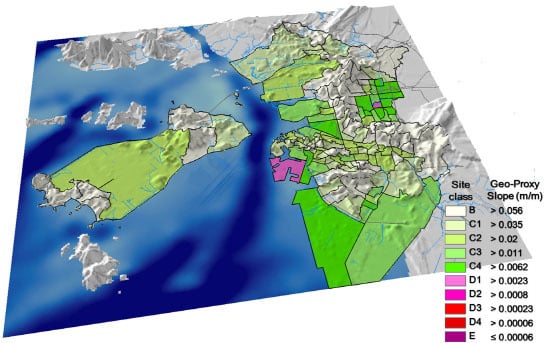Geo-Proxy-Based Site Classification for Regional Zonation of Seismic Site Effects in South Korea
Abstract
:1. Introduction
2. Site Classification System with Seismic Response Parameters
2.1. Seismic Response Parameters
2.2. Site Class Based on the Seismic Response Parameters in South Korea
3. Development of Site Classification with Geo-Proxies Using Geotechnical Database in Seoul
3.1. Study Areas and Geotechnical Database
3.2. Seismic Zonation Based on Site Response Parameters in Seoul
3.3. Framework for Site Classifaction Based on Geo-Proxy in South Korea
4. Seismic Zonation with Site Response Parameters and Geo-Proxies in Incheon
5. Conclusions
Acknowledgments
Author Contributions
Conflicts of Interest
References
- Sun, C.G. Applications of a GIS-based geotechnical tool to assess spatial earthquake hazards in an urban area. Environ. Earth Sci. 2012, 65, 1987–2001. [Google Scholar] [CrossRef]
- Sun, C.G. Geotechnical Information System and Site Amplification Characteristics for Earthquake Ground Motions at Inland of the Korean Peninsula. Ph.D. Thesis, Seoul National University, Seoul, Korea, February 2004. [Google Scholar]
- Sun, C.G.; Kim, D.S.; Chung, C.K. Geologic site conditions and site coefficients for estimating earthquake ground motions in the inland areas of Korea. Eng. Geol. 2005, 81, 446–469. [Google Scholar] [CrossRef]
- Sun, C.G. Suggestion of additional criteria for site categorization in Korea by quantifying regional specific characteristics on seismic response. KSCE J. Civ. Eng. 2010, 13, 203–218. [Google Scholar]
- Lee, S.H.; Sun, C.G.; Yoon, J.K.; Kim, D.S. Development and verification of a new site classification system and site coefficients for regions of shallow bedrock in Korea. J. Earthq. Eng. 2012, 16, 795–819. [Google Scholar] [CrossRef]
- Booth, E. The estimation of peak ground-motion parameters from spectral ordinates. J. Earthq. Eng. 2007, 11, 13–32. [Google Scholar] [CrossRef]
- Park, S.; Elrick, S. Predictions of shear-wave velocities in southern California using surface geology. Bull. Seismol. Soc. Am. 1998, 88, 677–685. [Google Scholar]
- Wills, C.J.; Petersen, M.; Bryant, W.A.; Reichle, M.; Saucedo, G.J.; Tan, S.; Taylor, G.; Treiman, J. A site-conditions map for California based on geology and shear-wave velocity. Bull. Seismol. Soc. Am. 2000, 90, S187–S208. [Google Scholar] [CrossRef]
- Holzer, T.L.; Padovani, A.C.; Bennett, M.J.; Noce, T.E.; Tinsley, J.C. Mapping NEHRP VS30 site classes. Earthq. Spectra 2005, 21, 353–370. [Google Scholar] [CrossRef]
- Douglas, J.; Edwards, B. Recent and future developments in earthquake ground motion estimation. Earth Sci. Rev. 2016, 160, 203–219. [Google Scholar] [CrossRef] [Green Version]
- Borcherdt, R.D. Estimates of site-dependent response spectra for design (methodology and justification). Earthq. Spectra 1994, 10, 617–653. [Google Scholar] [CrossRef]
- Earle, P.S.; Wald, D.J.; Allen, T.I.; Jaiswal, K.S.; Porter, K.A.; Hearne, M.G. Rapid exposure and loss estimates for the 12 May, 2008 MW 7.9 Wenchuan earthquake provided by the US Geological Survey’s PAGER system. In Proceedings of the 14th World Conference on Earthquake Engineering, Beijing, China, 12 October 2008; International Association for Earthquake Engineering: Tokyo, Japan, 2008. [Google Scholar]
- Wald, D.J.; Earle, P.S.; Allen, T.I.; Jaiswal, K.; Porter, K.; Hearne, M. Development of the US Geological Survey’s PAGER system (prompt assessment of global earthquakes for response). In Proceedings of the 14th World Conference on Earthquake Engineering, Beijing, China, 12 October 2008; International Association for Earthquake Engineering: Tokyo, Japan, 2008. [Google Scholar]
- Xu, L.; Di, H.; Feng, W.; Li, C. Estimation of the fault-near ground motion of the 2010 Yushu, Qinghai, Ms 7.1 earthquake. Chin. J. Geophys.-CH 2010, 53, 1366–1373. (In Chinese) [Google Scholar]
- Allen, T.I.; Wald, D.J. Topographic Slope as a Proxy for Global Seismic Site Conditions (VS30) and Amplification around the Globe; Open-File Report 2007-1357; U.S. Geological Survey: Reston, VA, USA, 2007.
- Farr, T.G.; Kobrick, M. Shuttle Radar Topography Mission produces a wealth of data. Eos Trans. Am. Geophys. Union 2000, 81, 583–585. [Google Scholar] [CrossRef]
- Allen, T.I.; Wald, D.J. On the use of high-resolution topographic data as a proxy for seismic site conditions (VS30). Bull. Seismol. Soc. Am. 2009, 99, 935–943. [Google Scholar] [CrossRef]
- Sun, C.G.; Kim, H.S. GIS-based regional assessment of seismic site effects considering the spatial uncertainty of site-specific geotechnical characteristics in coastal and inland urban areas. Geomat. Nat. Hazrd Risk 2017, 8, 1592–1621. [Google Scholar] [CrossRef]
- Kim, D.S.; Yoon, J.K. Development of new site classification system for the regions of shallow bedrock in Korea. J. Earthq. Eng. 2006, 10, 331–358. [Google Scholar] [CrossRef]
- Lee, S.J.; Liu, Q.; Tromp, J.; Komatitsch, D.; Liang, W.T.; Huang, B.S. Toward real-time regional earthquake simulation II: Real-time Online earthquake Simulation (ROS) of Taiwan earthquakes. J. Asian Earth Sci. 2014, 87, 56–68. [Google Scholar] [CrossRef]
- Study of Seismic Design Guideline (II). Ministry of Construction and Transportation. 1997. Available online: www.molit.go.kr (accessed on 23 January 2018). (In Korean)
- Borcherdt, R.D. Empirical evidence for site coefficients in building code provisions. Earthq. Spectra 2002, 18, 189–217. [Google Scholar] [CrossRef]
- Dobry, R.; Borcherdt, R.D.; Crouse, C.B.; Idriss, I.M.; Joyner, W.B.; Martin, G.R.; Power, M.S.; Rinne, E.E.; Seed, R.B. New site coefficients and site classification system used in recent building seismic code provisions. Earthq. Spectra 2000, 16, 41–67. [Google Scholar] [CrossRef]
- Sun, C.G.; Kim, H.S. Geostatistical assessment for the regional zonation of seismic site effects in a coastal urban area using a GIS framework. Bull. Earthq. Eng. 2016, 14, 2161–2183. [Google Scholar] [CrossRef]
- Kim, H.S.; Sun, C.G.; Cho, H.I. Geospatial Big Data-Based Geostatistical Zonation of Seismic Site Effects in Seoul Metropolitan Area. ISPRS Int. J. Geo.-Inf. 2017, 6, 174. [Google Scholar] [CrossRef]
- Sun, C.G.; Kim, B.H.; Park, K.H.; Chung, C.K. Geotechnical comparison of weathering degree and shear wave velocity in the decomposed granite layer in Hongseong, South Korea. Environ. Earth Sci. 2015, 74, 6901–6917. [Google Scholar] [CrossRef]
- Yun, H.S.; Lee, J.Y.; Yang, D.Y.; Hong, S.S. Areal Distribution Ratio of Rock ffes with Geologic Ages in the Gyeonggi-Seoul-Incheon Areas. J. Petrol. Soc. Korea 2007, 16, 208–216. (In Korean) [Google Scholar]
- Pilz, M.; Parolai, S.; Picozzi, M.; Wang, R.; Leyton, F.; Campos, J.; Zschau, J. Shear wave velocity model of the Santiago de Chile basin derived from ambient noise measurements: A comparison of proxies for seismic site conditions and amplification. Geophys. J. Int. 2010, 182, 355–367. [Google Scholar] [CrossRef]
- Wills, C.J.; Gutierrez, C.I.; Perez, F.G.; Branum, D.M. A next generation VS30 map for California based on geology and topography. Bull. Seismol. Soc. Am. 2015, 105, 3083–3091. [Google Scholar] [CrossRef]
- Rai, D.C.; Singhal, V.; Raj, S.B.; Sagar, S.L. Reconnaissance of the effects of the M7. 8 Gorkha (Nepal) earthquake of 25 April 2015. Geomat. Nat. Hazrd Risk 2016, 7, 1–17. [Google Scholar] [CrossRef]
- Kang, S.Y.; Kim, K.H. A Case Study of GIS-Based Site Classification in the Gyeongsang Province Constrained by Geologic and Topographic Information. J. Korean Assoc. Geogr. Inf. Stud. 2009, 12, 136–145. [Google Scholar]
- Sun, C.G. Determination of mean shear wave velocity to 30m depth for site classification using shallow depth shear wave velocity profile in Korea. Soil Dyn. Earthq. Eng. 2015, 73, 17–28. [Google Scholar] [CrossRef]
- Kim, D.S.; Chung, C.K.; Sun, C.G.; Bang, E.S. Site assessment and evaluation of spatial earthquake ground motion of Kyeongju. Soil Dyn. Earthq. Eng. 2002, 22, 371–387. [Google Scholar] [CrossRef]
- Felicetta, C.; D’Amico, M.; Lanzano, G.; Puglia, R.; Russo, E.; Luzi, L. Site characterization of Italian accelerometric stations. Bull. Earthq. Eng. 2017, 15, 2329–2348. [Google Scholar] [CrossRef]
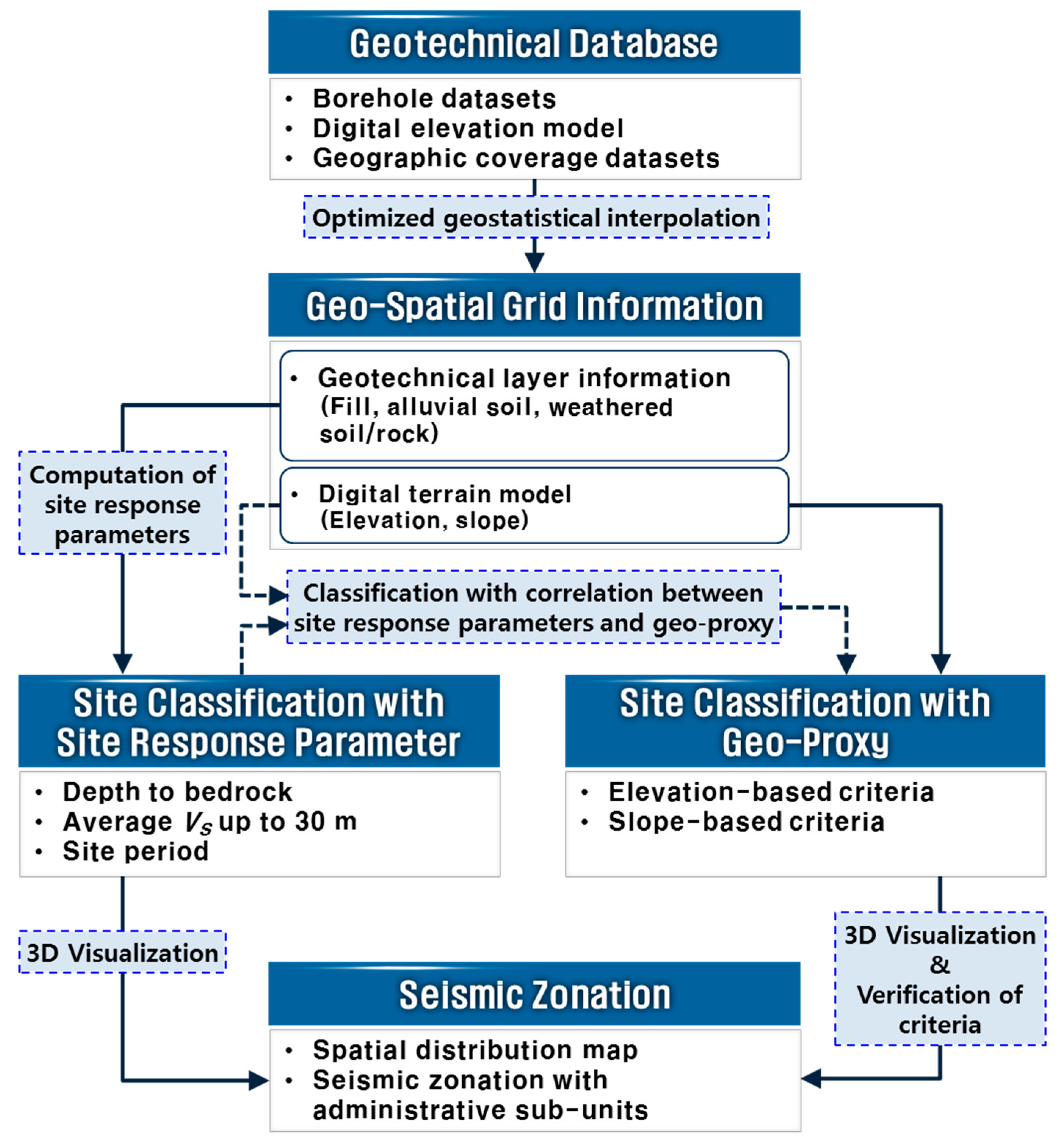







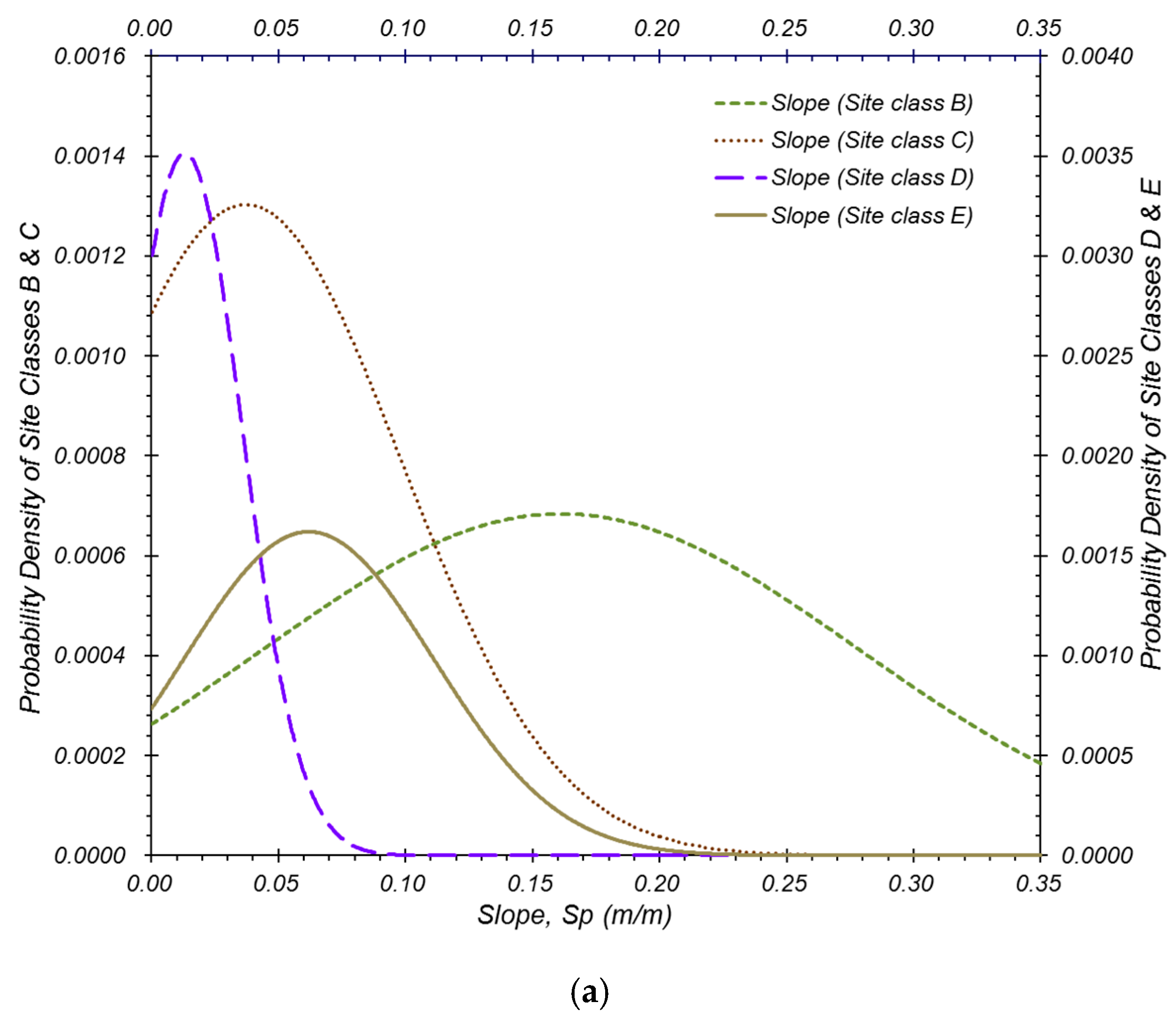
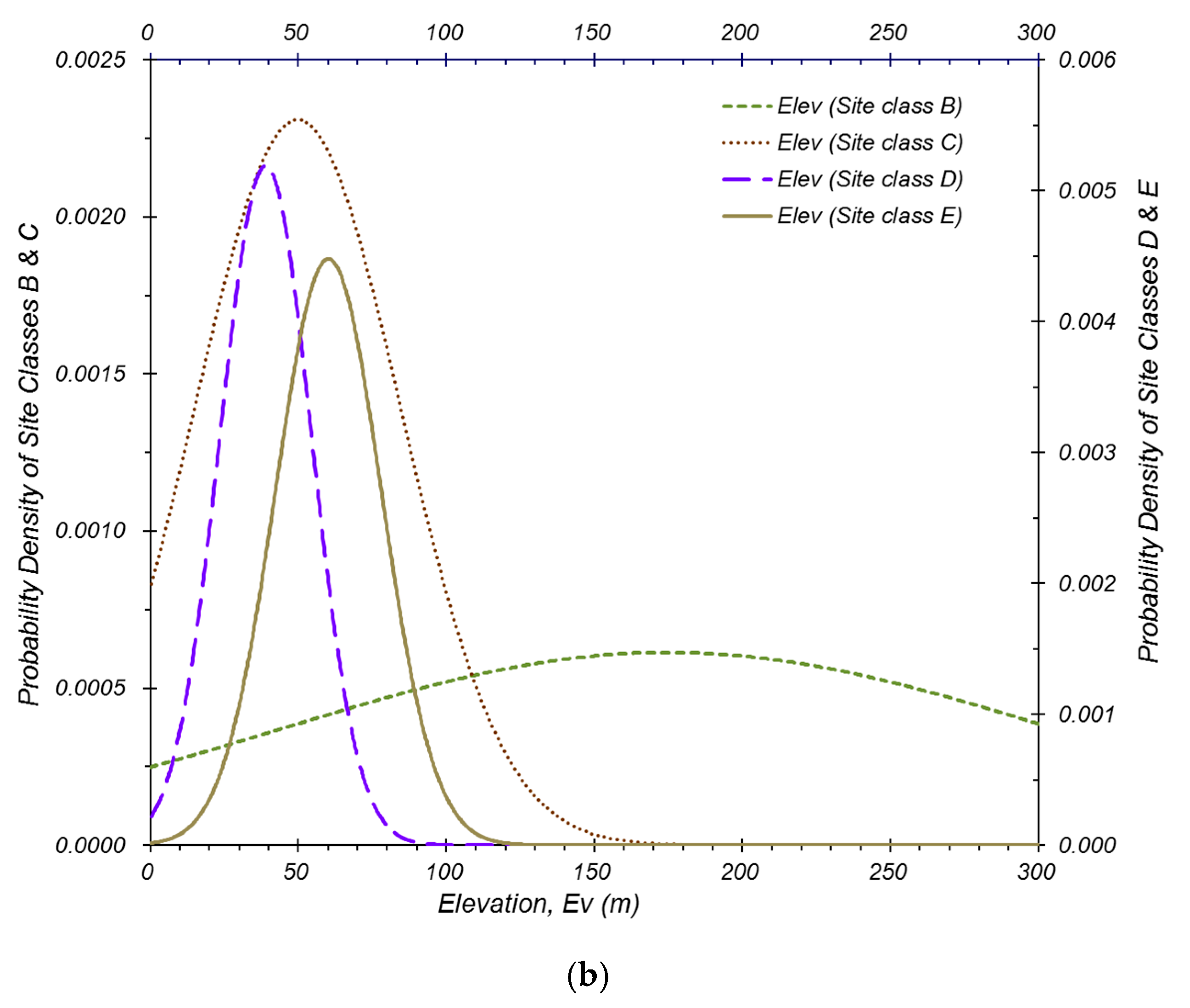
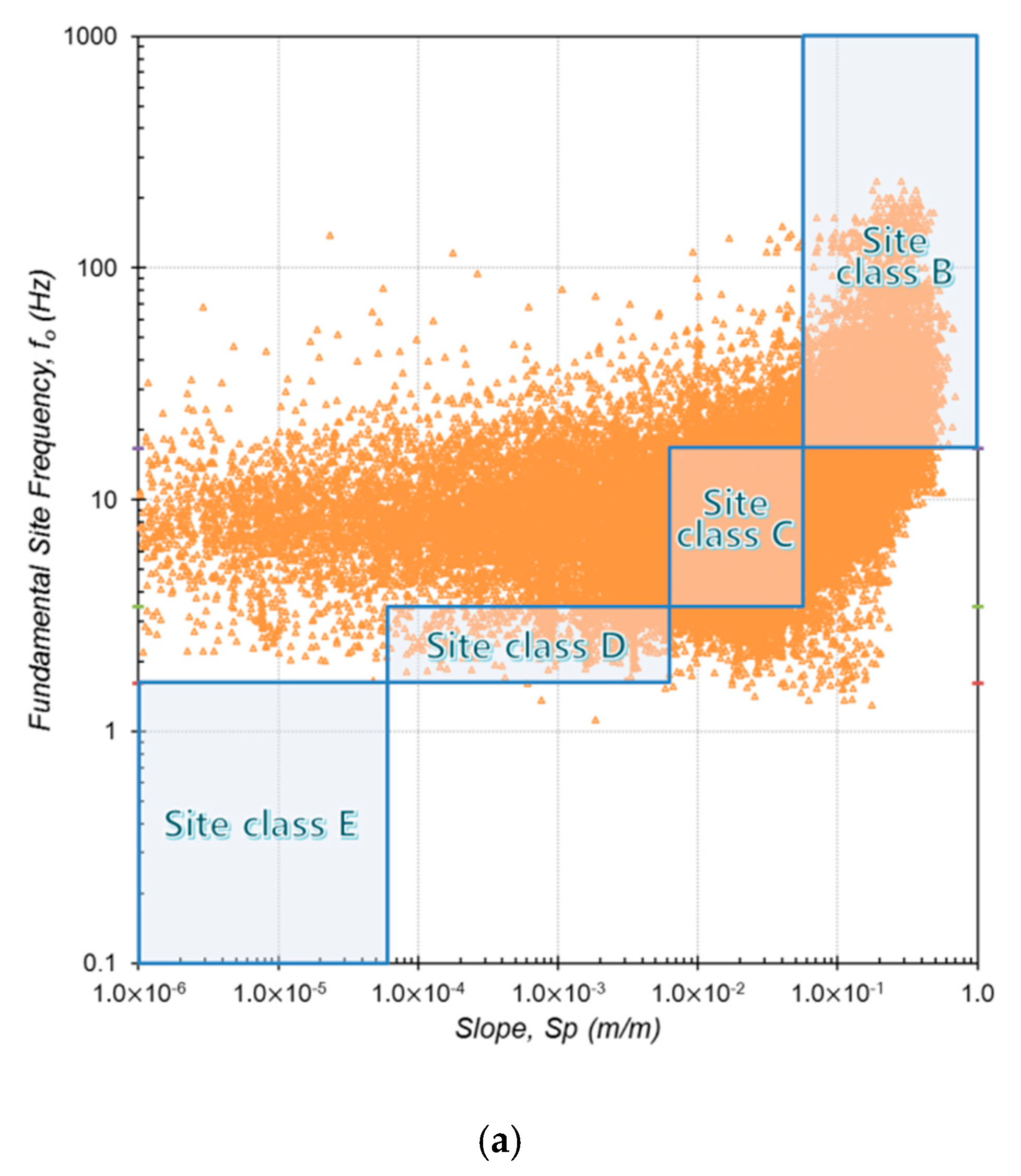
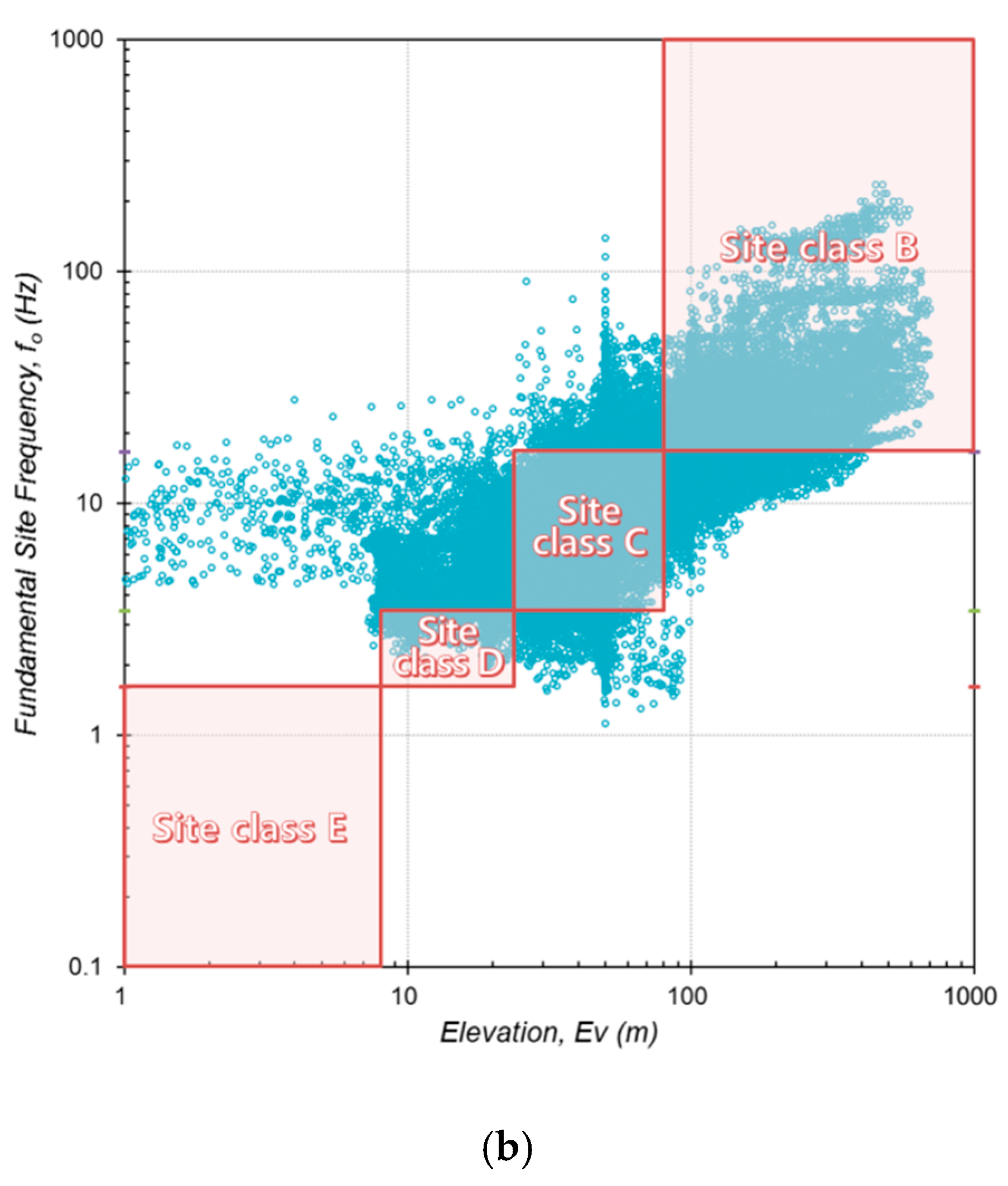
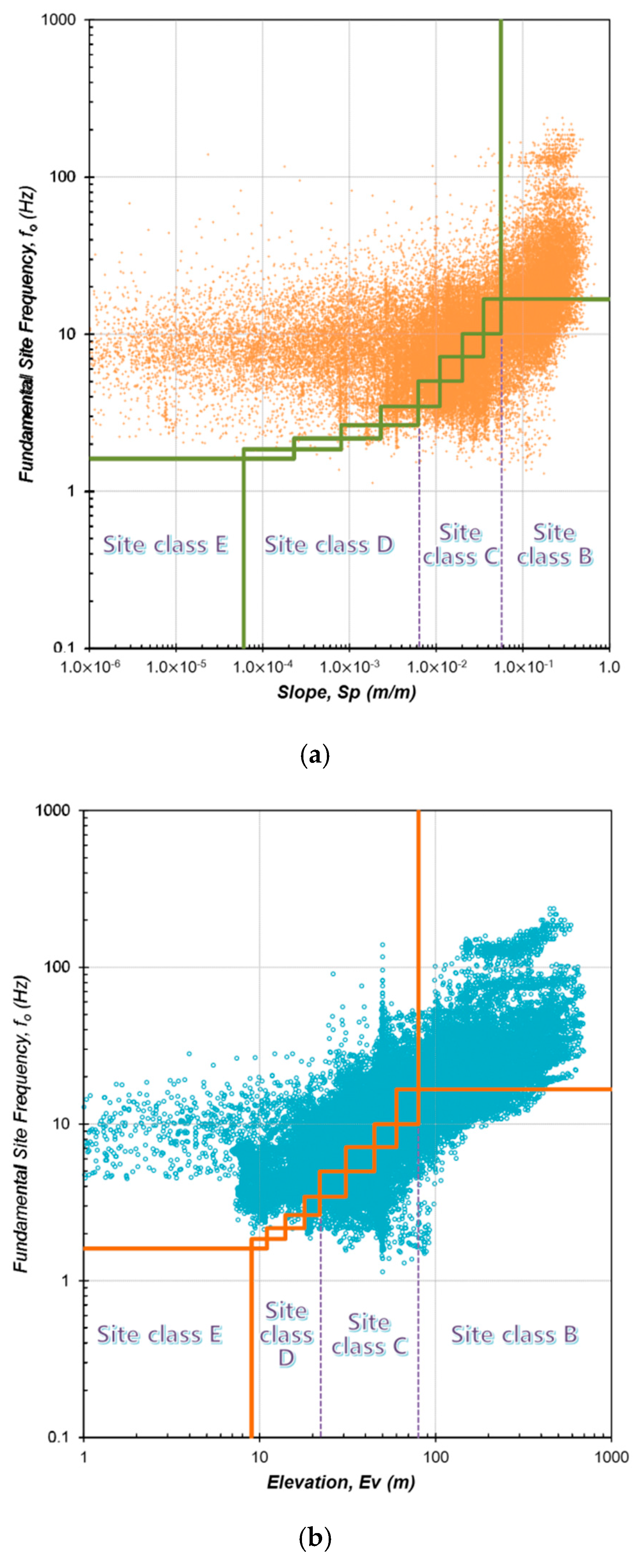


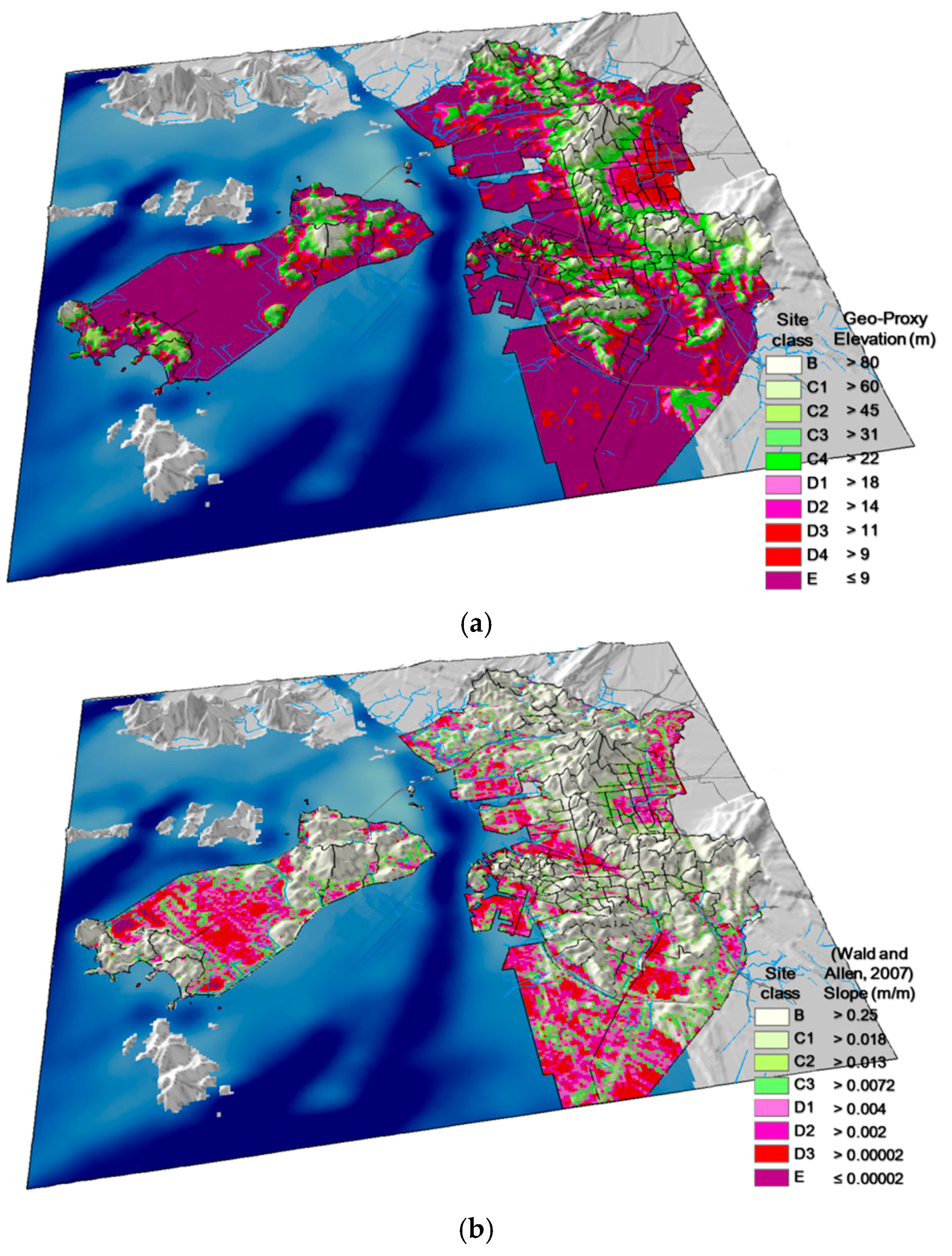



| Generic Description | Site Class | Criteria | Site Coefficients | ||||||
|---|---|---|---|---|---|---|---|---|---|
| Current | This Study | H (m) | VS30 (m/s) | VSDS (m/s) | TG (s) | Fa | Fv | ||
| Rock | A | B | <6 | >760 | >760Cs | <0.06 | 1.00 | 1.00 | |
| B | |||||||||
| Weathered Rock and Very Stiff Soil | C | C | C1 | <10 | >620 | >620Cs | <0.10 | 1.28 | 1.04 |
| C2 | <14 | >520 | >520Cs | <0.14 | 1.45 | 1.09 | |||
| Intermediate Stiff Soil | C3 | <20 | >440 | >440Cs | <0.20 | 1.65 | 1.13 | ||
| C4 | <29 | >360 | >360Cs | <0.29 | 1.90 | 1.19 | |||
| Deep Stiff Soil | D | D | D1 | <38 | >320 | >320Cs | <0.38 | 2.08 | 1.23 |
| D2 | <46 | >280 | >280Cs | <0.46 | 2.26 | 1.29 | |||
| D3 | <54 | >240 | >240Cs | <0.54 | 2.48 | 1.36 | |||
| D4 | <62 | >180 | >180Cs | <0.62 | 2.86 | 1.43 | |||
| Deep Soft Soil | E | E | ≥62 | ≤180 | ≤180Cs | ≥0.62 | 1.50 | 2.00 | |
| Area | Thickness of Fill (m) | Thickness of Alluvial Soil (m) | Thickness of Weathered Soil (m) | Thickness of Weathered Rock (m) |
|---|---|---|---|---|
| Seoul |  |  |  |  |
| Incheon |  |  |  |  |
| Site Class | Slope, Sp (m/m) | ||
|---|---|---|---|
| Class | Criterion, VS30 (m/s) | Active Tectonics | Stable Continent |
| B | 760 < VS30 | 0.138 < Sp | 0.025 < Sp |
| C | 620 < VS30 ≤ 760 | 0.10 < Sp ≤ 0.138 | 0.018 < Sp ≤ 0.025 |
| 490 < VS30 ≤ 620 | 0.050 < Sp ≤ 0.10 | 0.013 < Sp ≤ 0.018 | |
| 360 < VS30 ≤ 490 | 0.018 < Sp ≤ 0.050 | 0.0072 < Sp ≤ 0.013 | |
| D | 300 < VS30 ≤ 360 | 0.0063 < Sp ≤ 0.018 | 0.004 < Sp ≤ 0.0072 |
| 240 < VS30 ≤ 300 | 0.0022 < Sp ≤ 0.0063 | 0.002 < Sp ≤ 0.004 | |
| 180 < VS30 ≤ 240 | 0.0001 < Sp ≤ 0.0022 | 0.00002 < Sp ≤ 0.002 | |
| E | VS30 ≤ 180 | Sp ≤ 0.0001 | Sp ≤ 0.00002 |
| Site Class | Criteria | Proxies | ||||
|---|---|---|---|---|---|---|
| VS30 (m/s) | TG (s) | f0 (Hz) | Slope, Sp (m/m) | Elevation, Ev (m) | ||
| Stable Continent [15] | South Korea (Proposed in This Study) | South Korea (Proposed in This Study) | ||||
| B | >760 | <0.06 | >16.67 | >0.025 | >0.056 | >80 |
| C | >620 | <0.10 | >10.00 | >0.018 | >0.002 | >52 |
| >520 | <0.14 | >7.14 | >0.013 | >0.001 | >33 | |
| >360 | <0.29 | >3.45 | >0.0072 | >0.0062 | >22 | |
| D | >320 | <0.38 | >2.63 | >0.004 | >0.0026 | >16 |
| >280 | <0.46 | >2.17 | >0.002 | >0.0016 | >12 | |
| >180 | <0.62 | >1.61 | >0.00002 | >0.00006 | >9 | |
| E | ≤180 | ≥0.62 | ≤1.61 | ≤0.00002 | ≤0.00006 | ≤9 |
| Generic Description | Site Class | Criteria | Geo-Proxies | ||||
|---|---|---|---|---|---|---|---|
| VS30 (m/s) | TG (s) | f0 (Hz) | Slope, Sp (m/m) | Elevation, Ev (m) | |||
| Rock | B | >760 | <0.06 | >16.67 | >0.056 | >80 | |
| Weathered Rock and Very Stiff Soil | C | C1 | >620 | <0.10 | >10.00 | >0.035 | >60 |
| C2 | >520 | <0.14 | >7.14 | >0.02 | >45 | ||
| Intermediate Stiff Soil | C3 | >440 | <0.20 | >5.00 | >0.011 | >31 | |
| C4 | >360 | <0.29 | >3.45 | >0.0062 | >22 | ||
| Deep Stiff Soil | D | D1 | >320 | <0.38 | >2.63 | >0.0023 | >18 |
| D2 | >280 | <0.46 | >2.17 | >0.0008 | >14 | ||
| D3 | >240 | <0.54 | >1.85 | >0.00023 | >11 | ||
| D4 | >180 | <0.62 | >1.61 | >0.00006 | >9 | ||
| Deep Soft Soil | E | ≤180 | ≥0.62 | ≤1.61 | ≤0.00006 | ≤9 | |
© 2018 by the authors. Licensee MDPI, Basel, Switzerland. This article is an open access article distributed under the terms and conditions of the Creative Commons Attribution (CC BY) license (http://creativecommons.org/licenses/by/4.0/).
Share and Cite
Sun, C.-G.; Kim, H.-S.; Cho, H.-I. Geo-Proxy-Based Site Classification for Regional Zonation of Seismic Site Effects in South Korea. Appl. Sci. 2018, 8, 314. https://doi.org/10.3390/app8020314
Sun C-G, Kim H-S, Cho H-I. Geo-Proxy-Based Site Classification for Regional Zonation of Seismic Site Effects in South Korea. Applied Sciences. 2018; 8(2):314. https://doi.org/10.3390/app8020314
Chicago/Turabian StyleSun, Chang-Guk, Han-Saem Kim, and Hyung-Ik Cho. 2018. "Geo-Proxy-Based Site Classification for Regional Zonation of Seismic Site Effects in South Korea" Applied Sciences 8, no. 2: 314. https://doi.org/10.3390/app8020314




